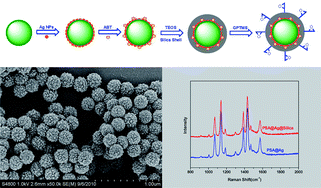Poly(styrene-co-acrylic acid) core and silver nanoparticle/silica shell composite microspheres as high performance surface-enhanced Raman spectroscopy (SERS) substrate and molecular barcode label
Abstract
A new type of polymer core and

* Corresponding authors
a
Key Laboratory of Molecular Engineering of Polymers (Minister of Education), Department of Macromolecular Science, Laboratory of Advanced Materials, Fudan University, Shanghai, China
E-mail:
ccwang@fudan.edu.cn
Fax: +86-21-65640293
Tel: +86-21-65642385
b School of Material Science and Engineering, Jingdezhen Ceramic Institute, Jingdezhen, China
c Department of Chemistry and Integrated Biosciences, The University of Akron, Akron, OH, USA
A new type of polymer core and

 Please wait while we load your content...
Something went wrong. Try again?
Please wait while we load your content...
Something went wrong. Try again?
J. Li, W. Ma, C. Wei, J. Guo, J. Hu and C. Wang, J. Mater. Chem., 2011, 21, 5992 DOI: 10.1039/C0JM04343E
To request permission to reproduce material from this article, please go to the Copyright Clearance Center request page.
If you are an author contributing to an RSC publication, you do not need to request permission provided correct acknowledgement is given.
If you are the author of this article, you do not need to request permission to reproduce figures and diagrams provided correct acknowledgement is given. If you want to reproduce the whole article in a third-party publication (excluding your thesis/dissertation for which permission is not required) please go to the Copyright Clearance Center request page.
Read more about how to correctly acknowledge RSC content.
 Fetching data from CrossRef.
Fetching data from CrossRef.
This may take some time to load.
Loading related content
